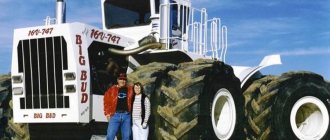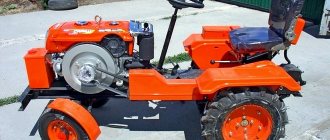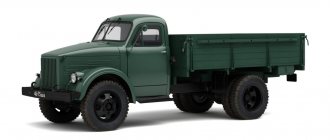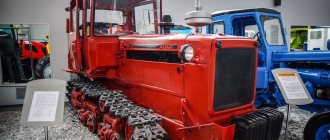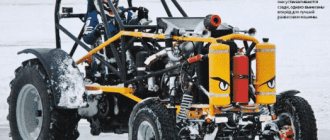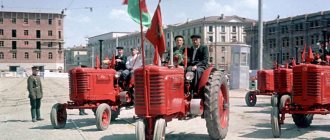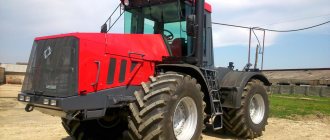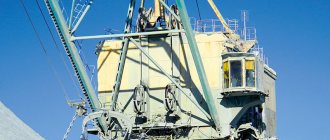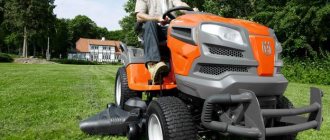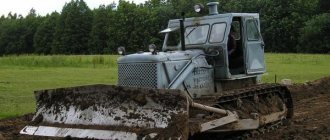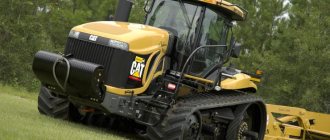The MTZ-80 tractor is one of the most common agricultural machines in the countries of the former USSR. Production of the unit began more than 40 years ago and continues to this day. Only the name has changed: today it is better known as “Belarus-80”.
This machine has high technical characteristics and a wide range of applications. To this day, it fully satisfies the needs of agriculture and is used as private property and for commercial purposes.
Tractor "KD-35"
0
Source:
See all photos in the gallery
November 4, 1950 was noted in the chronicle of the labor exploits of Belarusian tractor builders as the day the serial production of KD-35 tractors began. The first-born of Minsk tractor builders enjoyed great and well-deserved success among field workers. The KD-35 tractors were equipped with 4-cylinder diesel engines producing 37 hp. the engine was distinguished by significant efficiency. Thus, for one hectare of plowing under average conditions, it consumed 13 kg of fuel. The tractor's fuel tank contained fuel for 10 hours of uninterrupted operation. Prototypes of the machine plowed up to 6 hectares of land in 10 hours. The tractor was not produced by the plant for long, only 9 months, until August 1951. During this time, 406 cars rolled off the assembly line. The production of diesel and starting engines for the KD-35 at the plant did not stop. They were supplied to the Lipetsk Tractor Plant. Subsequently, this engine was used on a wheeled universal row-crop tractor, on which factory designers had been working since 1948.
Literature
- Authors' team.
Tractors MTZ-80 and MTZ-82 / Editors: I. S. Soroko, O. D. Aleksandrov. - M.: Kolos, 1975. - 248 p. — 100,000 copies. - Team of authors.
Tractors Belarus MTZ-80, MTZ-80L, MTZ-82, MTZ-82L / Executive editor - general designer of universal row-crop tractors I. P. Ksenevich. - Mn.: Urajai, 1977. - 352 p. — 100,000 copies. - Authors' team.
Tractors “Belarus” MTZ-80, MTZ-82 and their modifications / General designer P. A. Amelchenko. - Mn.: Urajai, 1990. - 174 p. — 60,000 copies. - Kalbus G. L.
Hydraulic drive and mounted systems of tractors. - Kyiv: Harvest, 1982. - P. 112-147. — 200 s. — 34,000 copies. - Kopylov Yu. M., Puhovitsky F. N., Sapozhnikov E. Zh.
Current repair of wheeled tractors. - M.: Rosagropromizdat, 1988. - 287 p. — 75,000 copies. — ISBN 5-260-00295-4. - Authors' team.
Tractors "Belarus" of the MTZ and YuMZ families. Design, operation, maintenance. - Mn.: Ranok, 2003. - 260 p. — 10,000 copies. — ISBN 966-502-007-2. - Solovyov A. N.
Handbook of an engineer at an enterprise of technological transport and special equipment. - M.: Infra-Engineering, 2000. - T. 1. - 1344 p. — 2000 copies. — ISBN 978-5-9729-0023-7. - Domestic agricultural tractors. An illustrated history of development over 100 years. 1896-1996. / Artist Kaminov V. N. - NATI. - M.: Vneshtorgizdat, 1996. - 54 p.
MTZ-1 and MTZ-2
0
Source:
The Belarus universal wheeled tractor was designed to work with mounted, semi-mounted and trailed agricultural machines. The design of the tractor was made in two modifications: MTZ-2 - for inter-row cultivation of low-stem crops with matching tracks of the front and rear wheels and MTZ-1 - for processing high-stem crops with close front wheels. The tractor was designed to operate on two wheels: low-pressure rubber cylinders and wheels with a rigid steel rim with spurs. The tractor had an independent power take-off shaft drive, a hydraulic system for lifting mounted implements, and was equipped with a removable adjustable tow hitch. July 18, 1949 became a significant day for all tractor manufacturers. The first Belarusian factory-designed wheeled tractor emerged from the gates of the experimental workshop. A prototype of a wheeled tractor subsequently became the basis for the creation of the MTZ-2 serial machine. In 1949, 7 prototypes were produced and underwent lengthy factory tests. A historical date for the plant’s staff was 1953, when on October 14, the assembly of the MTZ-1 and MTZ-2 tractors, created by the plant’s designers, was completed on the main conveyor. These machines determined the entire further specialization of the plant in the production of wheeled universal row-crop tractors.
×
0
Source:
Attachment system
"Belarus" is equipped with a three-point rear linkage system, a classic layout, with two longitudinal and one central links, braces and a power cylinder for raising and lowering the linkage with equipment. To control the hitch, as well as the hydraulics of mounted and trailed equipment, the tractor is equipped with a separate-aggregate hydraulic system, consisting of an NSh-32 gear oil pump driven by an engine, a three-section hydraulic distributor, and one or more hydraulic cylinders. There is a huge amount of different equipment for tractors of this model; listing them will take a lot of time, since back in the 70–80s the number of items exceeded well over 200.
KT-12 and KT-12A
0
Source:
In the spring of 1951, the MTZ team received a very important government task - to master the production of skidders, which were in great demand in the logging industry. The KT-12 gas generator tractor is a special tracked vehicle designed for forest skidding. It appeared in the USSR in the first post-war years. There were no analogues to it in any country in the world. Previously, skidding was carried out by horse-drawn vehicles, manual or mechanical winches. The KT-12 tractor was created by designers of the Kirov plant in Leningrad in collaboration with scientists from the Leningrad Forestry Academy. The KT-12 tractor was produced at the Kirov plant until 1951. Now it was necessary to establish its production at the Minsk Tractor Plant. Only three months were allotted to resolve all organizational issues. So, in the short history of its existence, MTZ had to develop a second (after the KD-35) machine, and, moreover, not of its own design. On August 15, 1951, the first batch of KT-12 skidding machines rolled off the main conveyor of the tractor assembly shop. During the production process, the tractor underwent modernization aimed at improving the performance of the machine. In a short period of time, factory designers, by changing a number of components and parts, increased the warranty period of the machine by 1.5 times.
TDT-40
0
Source:
In the early 50s, the USSR Ministry of Forestry Industry stated that the KT-12A with its gas generator installation did not meet the increased requirements. Considering the disadvantages of the tractor, the ministry decided to abandon this machine altogether and raised the question of creating a new, more reliable skidder with a power of 60 hp instead. Having analyzed the situation, the designers and management of MTZ recognized the feasibility of creating a more powerful skidder, but also expressed the opinion that one powerful class of tractor for all zones in all forestry operations would be uneconomical. It was necessary to design a medium-power skidder that could be created on the basis of the KT-12A by installing a diesel engine of a Belarus wheeled tractor on it. In 1954, they developed the design of such a tractor, giving it the brand TDT-40. The tractor was intended for transporting logs directly from the cutting area. In addition to timber skidding, it was indispensable in logging and in all kinds of transport work in off-road conditions. Based on the results of operational tests in 1955, the interdepartmental commission stated that the TDT-40 tractor was very necessary for the USSR Ministry of Forestry Industry and it was advisable to establish its production in a short time. By decision of the USSR Ministry of Tractor and Agricultural Engineering, serial production of TDT-40 diesel tractors began at MTZ in May 1956. By the end of the year, their number reached 3,430. In the same year, design work was completed and the first experimental D-50 diesel engines for the promising tractor were manufactured. The new engine exceeded the power of its predecessor by 10 hp, was smaller in size and 350 kg lighter.
TDT-54 and TDT -60
0
Source:
To work in the forests of the Urals, Siberia and the Far East, more powerful skidders were required than the TDT-40. The Ministry of Automotive Industry instructed the designers of the Minsk Tractor Plant to develop a project for such a tractor in conjunction with the Scientific Research Autotractor Institute (NATI) according to the technical requirements of the Ministry of Forestry Industry of the USSR. Initially, the tractor was given the brand TDT-54. To increase productivity, a D-54 diesel engine with a power of 54 hp was used. tractor DT-54 of the Kharkov Tractor Plant. After the skidder TDT-54 received the go-ahead from the state commission for mass production, a detailed analysis of each unit was carried out. As a result, it was decided to modernize most of its components. In addition, the D-54 diesel engine was boosted to 60 hp. and as a result, the tractor received a new name TDT-60. In 1956, four of its prototypes passed all control state tests under production conditions at the Vakhtansky timber industry enterprise in the Gorky region. The simultaneous production of two tractors, MTZ-2 and TDT-40, completely different in design and purpose, put the plant in a difficult position. The plant did not have the opportunity to simultaneously develop two different productions: the production of the MTZ-2 tractor, which was extremely necessary for agriculture, and the TDT-40 tractor, in which the USSR Ministry of Forestry Industry was interested. Technical and economic calculations showed that the Minsk Plant needs to specialize in the production of wheeled universal row-crop agricultural tractors. The management of the plant submitted a proposal to the ministry - to stop production of the TDT-40 tractor at MTZ, transferring it to the plant in Karelia, and the developed TDT-60 model to the Altai Tractor Plant. By decree of the USSR government of January 30, 1956, the Onega Machine-Building Plant in Petrozavodsk was transferred to the Ministry of Tractor and Agricultural Engineering of the USSR for the production of TDT-40 tractors. Before that, it was under the jurisdiction of the USSR Ministry of Forestry Industry. In 1957, without stopping the production of TDT-40 at MTZ, the development of the tractor began at the Onega Tractor Plant. In total, until 1958, MTZ produced 12,977 TDT-40 tractors. In 1957, the TDT-60 tractor was put into serial production at the Altai Tractor Plant. This was the end of the history of skidders at MTZ, where for 7 years they were produced in parallel with wheeled ones.
The lineup
As of the beginning of 2022, the Minsk Tractor Plant offers consumers the following models of tractors based on MTZ-80.1[18]:
Tractors
| 80.1 | 82.1 | 82.U | 820 | 892 | 892.2 | 90 | 92 | 900.3 | 920.3 | 920.4 | 920.5 | 920.6 | 952 | 952.2 | 952.3 | 952.4 | 952.5 | 952.6 | ||
| Engine model | D-243 | D-245.5 | D-243.1 | D-245.43S2 | D-245.43S2 | D-245.43S3A | D-245.43S3AM | D-245.43S4 | D-245.5 | D-245.5S2 | D-245.5S3AM | D-245.5S3V | D-245.5S4 | |||||||
| Power, l. s./kW | 81/59,6 | 84,3/62,0 | 88,4/65,0 | 90/66,2 | 84,3/62,0 | 88,4/65,0 | 95,2/70,0 | |||||||||||||
| Wheel formula | 4K2 | 4K4 | 4K2 | 4K4 | 4K2 | 4K4 | ||||||||||||||
| Load capacity on suspension axis, kg | 3200 | 4000 | 3200 | 4000 | ||||||||||||||||
| Specific fuel consumption, g/(kW h) | 229+3 | 226+3 | 235+3 | 229+3(5) | 220±5,0, 223±6,7 | 226+3 | 232+5 | 229+5 | 254±5,0 | 223±6,7 | ||||||||||
| Number of forward/reverse gears | 18/4 | 14/4 | ||||||||||||||||||
| Maximum permissible weight, kg | 6500 | 6190 | 7000 | 5900 | 6190 | 6750 | 7000 | |||||||||||||
| Aggregation of MTZ products | PLN-3-35P | PKM-3-40R, PLN-3-35P | MON-3-40 | |||||||||||||||||
Utility and construction vehicles
| 82MK | MUP-351 | P10M | |
| Harvesting machine | Harvesting and loading machine | Front loader | |
| Basic chassis | 82,2 | 82,1 | 82.1, 92P, 820, 952.2 |
| Loader productivity, t/h | − | 15—50 | |
| Nominal capacity of the loading equipment bucket, m³ | − | 0,5 | |
| Productivity when clearing the roadway of snow, m²/h | 21600 | − | |
| Maximum height of snow removed in one pass, mm | 500 | − | |
| Maximum brush width, mm | 1730 | − | |
| Wheel formula | 4K4 | ||
Special tractors
| 80X | 100X | 921.2 | 921.3 | 921.4 | ||
| Cotton growing tractor | Gardening tractor | |||||
| Engine model | D-245.1 | D-245S | D-245.5S | D-245.5S2 | D-245.5S3AM | |
| Power, l. s./kW | 81,6/60 | 107,4/79,0 | 89,8/66 | 95,2/70,0 | ||
| Wheel formula | 3K2 | 4K4 | ||||
| Load capacity on suspension axis, kg | 2800 | 3600 | ||||
| Specific fuel consumption, g/(kW h) | 244 | 232+11,60 | 229+6,87 | 254 ±12,70 | ||
| Number of forward/reverse gears | 16/4 | 14/4 | 18/4 | 14/4 | ||
| Maximum permissible weight, kg | 6500 | 6190 | 7000 | |||
Forestry machines
| L82.2 | TTR-401M | MPT-461.1 | ||
| Forestry tractor | Skidding tractor | Forestry conveyor loader | ||
| Engine model | D-243S | D-243S | ||
| Power, kW/l. With. | 59,6/81 | 60/82 | ||
| Wheel formula | 4K4 | |||
| Load capacity, kg | 3500 | 3500/9000 | ||
| Specific fuel consumption, g/(kW h) | 235 | 236 | ||
| Number of forward/reverse gears | 16/4 | |||
Previously produced tractor modifications
- MTZ-80
- Universal row-crop tractor, with rear-wheel drive and a small cabin. - MTZ-82R
- Wheeled rice tractor. - MTZ-82N
- Universal row-crop tractor, with all-wheel drive and low ground clearance (400 mm), wheels measuring 16.9/14-30 rear and 10-16 front, a seat with the ability to deviate from the longitudinal axis, to maintain a vertical position of the tractor driver, intended for work on slopes up to 16°. - MTZ-82K
- Steeply inclined universal row-crop tractor, with all-wheel drive, onboard oscillating gearboxes, a hydraulic system for automatic stabilization and alignment of the position of the frame, a front drive axle with parallelogram levers, additional hydraulic cylinders were also introduced into the hitch system to stabilize the aggregated machines, intended for work on slopes up to 20°. - MTZ-80ХМ
- Cotton-growing tractor, with one steered wheel, with final drive units, to increase ground clearance (650 mm), modification of the ХМ, distinguished by the installation of a D-240T engine (100 hp). - T-70V(S)
- Universal row-crop crawler tractor, class 2 tons, designed for cultivating grapes - "B" and sugar beets - "C". It differed from the base model in the type of propulsion - tracked; cabin, casing, low-power engine D-241L (70 hp), locked in the gearbox by 9th gear, modified by the hydraulic system. The size of the track chain differed from each other. - MTZ-80/82V
- Universal row-crop tractors, which differed from the basic ones by the presence of a reversible gearbox. - MTZ-82T
- Vegetable and melon modification of the base model. It was distinguished by increased ground clearance due to the installation of additional wheel gears. - MTZ-T80L
- Forestry modification of the tractor. Intended for wood skidding, reforestation work, work with agrochemicals and fire-fighting measures. It was distinguished by a lower-power D-243L (60 hp) engine shifted forward, a different cabin and trim, wheels of the same size 530-610, and a speed increased to 36 km/h.
MTZ-5
0
Source:
Time passed, and with it the requirements for the manufactured MTZ-2 tractor grew. It had a low transport speed (13 km/h) and an insufficient number of gears. The tractor began to lag behind in terms of fuel efficiency and material consumption. It was necessary to increase the reliability and service life of the machine. Having summarized the experience of operating MTZ-2 tractors, taking into account the state and level of tractor manufacturing, the plant’s design team in 1955-1956. carried out work on a radical modernization of the machine. This made it possible not only to eliminate existing shortcomings, but also to expand the scope of application of the machine and improve technical and economic indicators. This is how new models of the Belarus tractor appeared: MTZ-5 (1956 model). MTZ-5M and MTZ-5L (samples of 1957). MTZ-5, possessing great versatility, had an independent power take-off shaft drive, a more powerful and economical engine, and a hydraulic linkage system with remote cylinders.
Content
- 1 History of creation
- 2 Brief description of the model
- 3 Technical specifications 3.1 Engine
- 3.2 Power transmission 3.2.1 Clutch
- 3.2.2 Gearbox and transfer case
- 3.2.3 Rear axle
- 3.2.4 Front drive axle (MTZ-82)
- 4.1 Tractors
- 8.1 Comments
MTZ-5S
0
Source:
In 1959, after design improvements, production of the MTZ-5LS and MTZ-5MS tractors began. The letter “C” in the designation meant “high-speed”. Engine power was increased to 48 hp. (instead of 45) by increasing the speed to 1600 rpm (instead of 1500). The operating speed range was set within 5-10 km/h. The number of working gears in the gearbox was increased from four to five. Otherwise, there were no fundamental differences from the MTZ-5L and MTZ-5M tractors. Production of high-speed cars began in 1959.
The value of MTZ-82 for agriculture
The unit is able to operate in different climatic zones. The technical characteristics of the MTZ-82 allow it to be used to perform various types of work in fields, parks and squares, on livestock farms and private gardens.
The tractor can be equipped with vacuum water ring units and stationary devices. It performs well in joint work with loaders and bulldozers.
Maintenance of the MTZ-82 tractor is carried out quite simply and with minimal expenditure of money. Therefore, the unit is recommended for small private entrepreneurs.
On the Internet you can find many videos about how to assemble the MTZ-82 and how to repair the tractor in case of breakdowns.
There are various analogues of MTZ-82. Comparing its description with the characteristics of the AES-804 tractor, you can find many similarities. However, this model is not suitable for every entrepreneur due to its large dimensions and increased weight.
MTZ-7
0
Source:
In 1958, the design was finalized, prototypes were made, tests were carried out, and drawings for the MTZ-7 all-terrain tractor with four driving wheels were issued in preparation for production. The first tractor design was developed using the front drive axle from the military all-terrain vehicle GAZ-67, did not have an adjustable track width of the front wheels and therefore did not provide for row-crop work. Due to the insufficient strength of the GAZ-67 bridge, the tractor did not pass the tests. The problem was solved after a GAZ-63 drive axle was installed on the tractor. The production of cabins for Belarus tractors began. The design of the removable cabin made it possible to use it on the tractor completely closed and in the form of an awning. With the use of such a cabin, the working conditions of the tractor driver have significantly improved.
Chassis and tractor control
The front axle is balanced, has a semi-rigid suspension, thanks to the balancer it is able to follow surface unevenness regardless of the position of the rear axle and the tractor frame. The rear suspension is rigid, the wheels are mounted with clamp connections on the drive axles, this allows you to change the track width steplessly, in the range of 1400–2100 mm. The front track is adjustable in steps, the step is 100 mm. Disc brakes. “Belarus”, to help the driver, is equipped with hydraulic power steering. The principle of its operation is approximately the same as the operation of the power steering of any car. The oil pump creates pressure in the system, and the hydraulic distributor, receiving a signal from the steering wheel using cardan shafts, directs oil into one of the cavities of the hydraulic cylinder.
MTZ-50
0
Source:
Until 1959, MTZ had the capacity to produce only 18,000 wheeled tractors of the MTZ-2 type, 6,000 TDT-40 tracked skidders and 40,000 D-40 engines. Serial production of the MTZ-5, MTZ-5M, MTZ-5L tractors was still underway, work was carried out to modernize them, and in 1956 the designers basically designed a new diesel engine for the future MTZ-50 tractor. There was great interest in the creation of a new promising row-crop tractor not only at the plant, but also in the country. The technical design of the tractor was completed in 1957 and approved by the Main Scientific Automotive and Tractor Institute. In 1958, the experimental workshop produced several prototypes of the tractor. Based on the test results, the scientific and technical council of the VO "Soyuzselkhoztekhnika" recommended the wheeled universal row-crop tractor class 1.4 "Belarus" MTZ-50 for mass production. The MTZ-50 tractor was equipped with a 55 hp diesel engine, the weight of the machine was reduced by more than 400 kg. The tractor transmission was equipped with a 9-speed gearbox, providing a speed range ranging from 1.65 to 25 km/h.
Specifications
Engine
The MTZ-80 (82) tractors and their modifications are equipped with four-cylinder, four-stroke diesel engines of the Minsk Motor Plant of the D-240, D-243, D-245 family of liquid cooling.
Working volume (not less) - 4.75 l. Rated power in the original version is 55.16 kW (75 hp). The power was then increased to 59.25 kW (80 hp). The turbocharged engine has a power of 67.5…100 kW (90…136 hp). The engine is started by an electric starter or a PD-10 petrol carburetor starting device with a rated power of 10 hp. With. Currently, only electric starters are installed on engines. On some models, a PZHB-200B pre-start gasoline heater was installed. [8][9][10].
Power transmission
The power transmission is used to transmit rotation from the engine shaft to the drive wheels of the tractor, to the power take-off shaft, as well as to change the magnitude and direction of the transmitted torque.
On the MTZ-80 and MTZ-82 tractors, a stepped (mechanical) transmission is used, consisting of various types of gear wheels. Torque control is carried out by changing gear ratios.
The power transmission of MTZ-80 (82) tractors consists of the following components and mechanisms:
- clutch,
- gearbox and transfer case,
- rear drive axle with final drive, differential and final drives.
In the MTZ-82 tractor, torque is also supplied to the front drive wheels, for which the power transmission additionally uses a transfer case, cardan transmission and front drive axle. The power transmission units and mechanisms are located in three housings (clutch, gearbox and rear axle), fastened together into a single block, forming part of the tractor frame [8][9][10].
Clutch
The tractor is equipped with a friction, dry, single-disc, permanently closed clutch, controlled by a pedal from the cab. The transmission of torque in such a clutch is carried out due to the friction forces that arise when the drive and driven disks are compressed.
The clutch is equipped with a brake, which ensures that when the clutch is disengaged, both the clutch shaft and the associated gearbox input shaft are stopped. The presence of a brake also facilitates gear shifting and increases the service life of gears[8][9][10].
Gearbox and transfer case
The transmission on the tractor is mechanical, with nine forward gears and two reverse gears. Gear shifting is carried out by one lever mounted on a ball joint in the upper cover of the gearbox and sealed with a rubber boot. The lower end of the lever fits into the grooves of the fork sliders and, when changing gears, moves the required slider. The speed reducer is used to reduce the first and second gears of forward and reverse gears. When using a reduction gearbox, the number of gears doubles.
Designed to change transmission gear ratios and obtain different speeds and traction forces when the tractor moves forward and in reverse. In addition, the gearbox provides drive for the rear and side power take-off shafts, creeper, and transfer case of the front drive axle for MTZ-82 tractors. Power is taken off to the front drive axle from the driven gear of the first stage through an intermediate gear, which is installed on the right side in the gearbox housing cup.
The gearbox housing contains the primary and secondary shafts, a parallel intermediate shaft, a low gear and reverse shaft, gears and two gear stages, as well as drive gears for the speed reducer and transfer case [8][9][10].
The transfer case serves to distribute the torque transmitted from the gearbox between the drive axles of the tractor. With its help, automatic or forced switching on and off of the front axle (MTZ-82) is carried out.
The transfer case on tractors of the MTZ-80 family is designed as a single-stage gear reducer with a one-way roller freewheel clutch and a mechanism that disables, engages and blocks the freewheel. The transfer case is mounted on two pins and bolted to the transmission hatch on the right side[8][9][10].
Rear axle
The rear axle is used to transmit torque from the longitudinally located secondary shaft of the gearbox through the main gear and differential to the final drives and axle shafts on which the hubs of the drive wheels are mounted.
All components and mechanisms of the bridge are housed in a cast-iron housing, the gearbox is attached to the front wall, and the rear power take-off shaft gearbox and the linkage mechanism bracket are attached to the rear wall. The final drive gear housings, brake casings and rear axle sleeves are attached to the side walls of the housing. The top of the case is closed with a steel lid[8][9][10].
The rear axle assemblies of the MTZ-80 (82) and MTZ-50 (52) tractors are interchangeable[8].
The rear axle is equipped with a differential with an automatic locking function (ALD). The locking mechanism consists of a hydraulically driven friction clutch located on the left final drive gear shaft. The clutch hydraulic drive is implemented from the power steering where the differential lock sensor is installed. When the tractor is operating, the clutch disks are compressed under hydraulic fluid pressure and the locking shaft, rigidly connected to the clutch pressure disks, closes the left side differential gear and crosspiece, resulting in the rear wheels and differential being locked[11]. There is an operating mode switch on the dashboard[12][9][10].
On tractors equipped with HSC (hydraulic volume steering) with a differential lock valve and a metering pump, the rear axle differential is locked using a hydraulically driven pedal installed on the cab floor[13][14].
Final drives are the last element of the transmission that transmits rotation and torque from the final drive and differential to the drive wheels of the tractor. Each final drive is a single-stage gearbox with a pair of spur gears[12][9][10]. The final drives, axle shafts and axle sleeves of the MTZ-80 (82) and MTZ-50 (52) tractors are unified, with the exception of the left drive gear[15].
Front drive axle (MTZ-82)
The front drive axle transmits torque from the power transmission drive to the front steered drive wheels and serves as the front support of the tractor frame. The bridge design is portal-universal. With this solution, on a tractor with 4 driving wheels, all the universality parameters of the base model are completely preserved: ground clearance, track adjustment limits, turning radius, etc. The front axle consists of a main gear, differential and wheel gearboxes
The drive axle is installed in the opening of the front beam of the semi-frame. The front axle body is pivotally connected to the beam, which allows the bridge to swing relative to the half-frame in the transverse plane of the tractor at an angle of 8-9°, limited by the stop of the protrusions on the body and the bridge cover. The front drive axles of the MTZ-82 and MTZ-52 tractors are interchangeable[16].
The front axle of the MTZ-82 tractors is equipped with a self-locking limited-slip differential and consists of two housings containing four satellites on two axles, two semi-axial gears and two pressure cups with friction disc packs. When the differential is locked, torque is transmitted to the side gears not only due to the frictional forces of the friction discs, but also through the teeth of the satellites.
It should be noted that in this case, the moments transmitted to the satellite teeth on the left and right sides are the same in magnitude, but at the same time, the moments transmitted due to friction forces to the semi-axial gears may differ depending on the adhesion values of the wheels with the coating on which the tractor is following [8][9][10].
Chassis and steering
The chassis serves as a support for the tractor and forms a trolley with the help of which the tractor moves. The chassis consists of a semi-frame frame, a front axle, rear and front wheels.
Steering is designed to maintain directional movement of the tractor and includes a steering gear, steering mechanism and steering linkage. The steering of the MTZ-80 and MTZ-82 tractors is equipped with a hydraulic power steering (HPS) or hydrostatic steering (HPS), which makes it possible to significantly reduce the force applied to the steering wheel when turning the front wheels of the tractor [8][9][10].
Rear wheel suspension - rigid
.
The front wheels have a semi-rigid
suspension with a balancing axle. The rear wheels are fixed to the drive axles using clamp connections, which allows you to continuously change the track width within the range of 1400-2100 mm. The front wheel track is also adjustable within the range of 1200-1800, but in steps, in increments of 100 mm. Ground clearance is 465 mm for the main modifications, 650 mm for modifications equipped with wheel gears, and 400 mm for the MTZ-82N modification. Disc brake mechanisms.
Hydraulic linkage system
The tractor is equipped with a separate-unit hydraulic linkage system with a position-force regulator and a hydraulic traction weight increaser. It consists of a gear pump NSh-32, a main and two remote hydraulic cylinders, a hydraulic gravity booster, a spring hydraulic accumulator, a position-force regulator, a tank for working fluid (hydraulic oils GOST 17479.3-85), pipelines, locking couplings and a mechanism for hanging machines[ 17].
The hydraulic mounted system is designed for aggregation and operation of the tractor with agricultural machines, soil cultivation tools and is used to control mounted, semi-mounted and hydraulic trailed mechanisms. The system is also used to create and regulate, using a hydraulic mechanism, additional load on the rear drive wheels due to the gravity of the mounted machine, in order to increase the traction force of the tractor and reduce its slipping. It is possible to use the hydraulic system to solve a number of auxiliary operations (lifting the tractor, etc.)[17][9][10].
MTZ-52
0
Source:
In 1959, based on the results of state tests, the design of the MTZ-50 tractor was finalized, the necessary documentation was issued and put into preparation for production. Based on the MTZ-50 tractor, a modification of the all-terrain tractor with four driving wheels, the MTZ-52, was developed. Due to lower slipping losses, the fuel efficiency of the MTZ-52 tractor is higher at all operating limits than the MTZ-50 tractor. On November 14, 1959, the Council of Ministers of the USSR issued a resolution “On the organization of specialized production of wheeled tractors, motorcycles and engines for them at enterprises of the BSSR.” One of the points of the document stated: 2. Oblige the Council of Ministers of the BSSR to ensure: c) the production of Belarus MTZ-50 tractors starting in 1961 and MTZ-52 tractors starting in 1962, increasing the production of tractors of these brands to 75,000 units in 1965 year. The Council of the National Economy of the BSSR, by its decision of December 19, 1961, decided: 3. For a non-stop transition to a new tractor model, provide for the phased introduction of the MTZ-50 tractor, for which: - approve the transition model MTZ-50 tractor for production at MTZ for 1961-1962 PL on the chassis of the MTZ-50 tractor with a serial D-48 PL engine, boosted to 50 hp. - production of MTZ-50 tractors with the D-50 engine will begin in the fourth quarter of 1962. 1960 The plant is under reconstruction. New equipment was installed in the workshops and outdated equipment was replaced. The design of the MTZ-50 tractor was finalized, the necessary documentation was issued and put into preparation for production. Based on the MTZ-50 tractor, the plant's design team developed a modification of the high-cross-country tractor with four driving wheels MTZ-52. This machine complemented the basic model and expanded its scope of application in agricultural and transport work, especially in conditions of high soil moisture.
Notes
Comments
- The table shows the main characteristics of tractors that can be freely purchased or ordered at the factory or from official dealers in 2022. Some transitional models or those not intended for the Russian market are not reflected in the table. The full catalog of models of tractors and machines produced by the Minsk Tractor Plant can be found on the official website.
Sources
- Domestic agricultural tractors. An illustrated history of development over 100 years, 1996.
- Product history. Tractor MTZ-80, 2015.
- A familiar stranger from Moldova, 2001.
- Tractor MTZ-80 Belarus | Agricultural machinery and tractors of the USSR
- New tractor MTZ-82. Restyling of the legend
- Baltic farmers on an old Belarus tractor went to Brussels, 2012.
- Tractors "Belarus" of the MTZ and YuMZ families. Design, operation, maintenance, 2003.
- ↑ 123456789
Ksenevich, 1975. - ↑ 1234567891011
Ksenevich, 1977. - ↑ 1234567891011
Levkov, Bruenkov, 1990. - Kopylov, Pukhovitsky, Sapozhnikov, 1988, p. 142.
- ↑ 12
Ksenevich, 1975, p. 131-133. - Group: Control of rear axle differential lock using a pedal. Information video.
- "MTZ-Siberia": Locking the differential of the rear axle MTZ-82.1 using a pedal, description, diagrams.
- Ksenevich, 1975, p. 92.
- Ksenevich, 1975, p. 100.
- ↑ 12
Kalbus, 1982, p. 112. - Official website of the Minsk Tractor Plant, products, tractors
MTZ-50X
0
Source:
In 1963, the design development was completed and prototypes of the MTZ-50 cotton-growing tractor were produced. The tractor is designed for cultivating and harvesting cotton in a four-row machine system with a row spacing of 90 cm. The MTZ-50X tractor was fundamentally different from the MTZ-50 tractor in the design of the front axle - it had one guide wheel. The final drive assembly with additional gearboxes was also changed. All necessary tests of the tractor were completed in 1966, after which preparations began for its mass production by factory services. Production of the MTZ-50X tractor lasted eight years: from 1969 to 1977. Then production was transferred to the Tashkent Tractor Plant.
Three tracked modifications were created on the basis of the MTZ-50 tractor, and the unit unification with the MTZ-50 tractor was more than 62%. Tracked modifications were unified by 95-98%. In 1967, a version of the T-54V tracked tractor was put into production in two modifications: T-54V-S1 with a track width of 950 mm for cultivating vineyards with row spacing of 1.8 m or more, and T-54V-S2 with a track width of 85- mm for cultivating vineyards with row spacing of 1.5 m. In 1968, production of the T-54L tractor began.
MTZ-80
0
Source:
In 1966, Decree of the Council of Ministers of the USSR No. 606 was issued on the creation of a universal row-crop tractor with a power of 75-80 hp. traction class 1.4. The designers created such a tractor by modernizing the MTZ-50 tractor, assigning it the MTZ-80/82 brand. In addition to increasing the power of the serial engine, a significant number of improvements were made to the design of this tractor. In 1972, state tests of the MTZ-80/80L tractor (with electric starter and starting engine) were completed. Tests have shown that the number of machines and implements mounted with the tractor has increased to 230 items. High speed (up to 35 km/h) made it possible to use the tractor more efficiently for transport work. In 1974, the plant began serial production of the MTZ-80. The tractor was conceived as a base one, taking into account the development of a new family of unified energy-rich tractors, both wheeled and tracked. The main differences between the MTZ-80 tractor and the MTZ-50 tractor were the following: A reduction gearbox was installed in the gearbox, doubling the number of gears - 18 forward gears and 4 reverse gears; Damping springs were introduced into the clutch coupling, the design of the flywheel was changed - it became flat, which improved ventilation of the entire clutch compartment and cleaning the cavity from wear products of rubbing surfaces; A creeper has been introduced - a gear reducer, which expands the speed range of the tractor. Its use allowed the tractor to move at speeds of up to 1.3 km/h; The automatic differential lock of the rear axle has also undergone changes. Now the blocking could be carried out while the tractor was moving; A change in the design of the rear PTO drive made it possible to obtain two rotation speeds instead of one; The hydraulic suspension system has also been modernized. It is equipped with a hydraulic adhesion weight increaser (GSV), a force and position regulator. The system's load capacity has been increased to 2000 kg (instead of 1500) by increasing the pressure in the system from 130 to 160 kg/cm2; The Minsk Motor Plant was involved in modernizing the engine. The engine had two modifications with electric start. The crankshaft speed was raised to 2200 rpm.
Minsk Tractor Plant: the country's calling card
Issue No. 45. Article No. 2. The first experimental universal wheeled tractor with a traction class of 1.4 tons, the MTZ-80 with a D-240 diesel engine, was manufactured in 1971.A year later, based on test results, the State Commission recommended the MTZ-80 and its all-wheel drive version MTZ-82 for mass production.
Production of anniversary MTZ tractors, units.
| III quarter 1958 | 100 000 |
| 08/22/1961 | 200 000 |
| 08/10/1963 | 300 000 |
| 08/23/1964 | 400 000 |
| 07/08/1966 | 500 000 |
| November 24, 1967 | 600 000 |
| 02/25/1969 | 700 000 |
| 05/23/1970 | 800 000 |
| 08/21/1971 | 900 000 |
| 05.12.1972 | 1 000 000 |
| 03/24/1984 | 2 000 000 |
| 06.1995 | 3 000 000 |
In 1974 a record was started - serial production of the most massive and longest-produced tractor in the world began
. The “Eightieth” series has become the calling card of not only the enterprise, but also the country. MTZ-80 was the first Soviet tractor to successfully pass difficult exams at the International Testing Center in Nebraska (USA).
Simple, unpretentious, reliable and very comfortable “Belarus” by the 1980s became the basis for the creation of a large number of models.
Now MTZ is well known in more than 100 countries on all continents, and approximately 80% of universal wheeled tractors in the CIS countries are manufactured in Minsk.
Only the skeleton was similar to the previous “50th” series MTZ-80/-82. The “Eighties” received a new tail, cabin, engine, 9-speed gearbox with reduction gear, rear axle differential with automatic locking, rear two-speed PTO, larger tires, pneumatic outlet for trailer brakes, etc.
A more modern spacious cabin began to be installed in 1980: it had panoramic glazing, a rigid safety cage, an air heating and cooling system, a seat adjustable according to the height and weight of the driver, new electric wipers for the rear and front windows, an improved steering column (now it was adjustable according to height and reclined for ease of entry and exit from the cabin).
In 1975, the annual export of MTZ tractors exceeded 18 thousand. , the Minsk Tractor Plant Production Association was organized
, which, in addition to the main enterprise, included: • Plant of special tools and technological equipment, • Vitebsk plant of tractor spare parts, • Bobruisk plant of tractor parts and units, • Head specialized design bureau for universal row-crop tractors.
A year later, the plant’s design team was awarded the State Prize of the Belarusian SSR for the creation of the MTZ-80.
| Early MTZ wheeled tractors | |||
| MTZ-80NR (1976-1980-2000) | MTZ-82 (1974-1980-2000) | MTZ-80PG (1976-1980) | MTZ-80 (1974-1980-2000) |
| MTZ-82K (1982-2000) | MTZ-80T (1980-1986) | ||
| MTZ-82ХМ (since 1986) | Belarus 800 (1977-1991) | MTZ-80ХА (since 1984) | |
The model range included new modifications: MTZ-82R
for cultivating rice crop rotation,
MTZ-82N
with low clearance for working on slopes up to 16°,
MTZ-82NR
for tall crops, steep slope
MTZ-82K
with a hydraulic frame stabilization system on slopes up to 20° , three-wheeled cotton
MTZ-80X
, half-track
MTZ-80PG
and
MTZ-80PGH
, as well as a very outlandish walk-behind tractor
MTZ-0.5
with a 5-horsepower engine.
However, many of these machines went into mass production only in 1982. MTZ-82R were manufactured
, in mountainous areas, tests of the steep-slope
MTZ-82K
and the first batch of five hundred low-clearance
MTZ-82N
.
These machines were very necessary, since more than half of the arable land was on hilly plains, and most of the sloping lands are located in the Black Earth Region, where up to 600 mm of precipitation falls per year and where vertical plowing - from the foot to the top - leads to increased soil erosion. Tractors MTZ-82N
and
MTZ-82K
are capable of contour plowing of slopes.
There were some difficulties when putting mini-equipment into production
.
The instigators of the new direction in 1974 were I. Stulba and N. Shulba, employees of the GSKB Consumer Goods Bureau. Four years later, work began on creating a family of small-sized agricultural products. machines: walk-behind tractors with a power of 6,8,12 hp. (MTZ-06, MTZ-08BS, MTZ-12
) and four-wheeled mini-tractors
MTZ-082
with a power of 12 hp. The decree of the CPSU Central Committee and the USSR Council of Ministers “On measures for the further development of personal subsidiary plots”, issued in 1979, helped to speed up events on the creation of a range of mini-equipment. Having outgrown the “walk-behind tractor group” in 1981, the specialized design bureau headed by Anton Kuznetsov was only able to produce 500 walk-behind tractors in 1982, which instantly became in short supply. The plans were to build a workshop to produce 15 thousand walk-behind tractors and mini-tractors. Subsequently, the Smorgon Aggregate Plant, built in 1986, began to produce them, and the State Prize of the Republic of Belarus for the creation of small-sized equipment found its heroes only in 1995.
Technical characteristics of MTZ-80/-82 series tractors
| Tractor type | MTZ-80 | MTZ-82 | MTZ-82N | MTZ-80L | MTZ-82K | MTZ-80X | MTZ-82R | MTZ-82NR |
| Year of issue | since 1974 | since 1974 | since 1982 | since 1976 | since 1982 | since 1974 | since 1982 | since 1976 |
| Wheel formula | 4x2 | 4x4 | 4x4 | 4x2 | 4x4 | 3x2 | 4x4 | 4x4 |
| Traction class, t | 1,4 | 1,4 | 1,4 | 1,4 | 1,4 | 1,4 | 1,4 | 1,4 |
| Curb weight, kg | 3160 | 3270 | 3500-3670 | 4400 | 4000 | 3470 | 4100 | 4108 |
| Overall dimensions, mm | 3815x1970x2470 | 3930x1970x2470 | 3850x1970x2424 | 3900x2400x2820 | 4250x2200x2790 | 4040x2326x2660 | 4020x2400x3080 | 4020x2400x3090 |
| Turning radius, m | 3,6 | 4,3 | 3,4 | 4,0 | 4,3 | 1,5 | 4,3 | 4,3 |
| Base, mm | 2370 | 2450 | 2450 | 2600 | 2880 | 2470 | 2450 | 2450 |
| Ground clearance, mm | 650 | 650 | 405 | 516 | 550 | 830 | 660 | 670 |
| Track front/rear, mm | 1200-1800/ 1350-2100 | 1200-1800/ 1350-2100 | 1400-1800/ 1350-2100 | 1800 | 1500-1800 | 1900 | 1900 | 1900 |
| Engine | D-240 | D-240L | D-240L | D-243 | D-240L | D-240L | D-240L | D-240L |
| Tires front/rear | 7,5-20/ 15,5-38 | 11,2-20/ 15,5-38 | 11,2-20/ 15,5-38 | 530-610/ 530-610 | 11,2-20/ 15,5-38 | 7,5-20/ 15,5-38 | 11,2-20/ 15,5-38 | 11,2-20/ 15,5-38 |
| Power, hp | 80 at 2200 min-1 | 80 at 2200 min-1 | 80 at 2200 min-1 | 60 at 1800 min-1 | 80 at 2200 min-1 | 80 at 2200 min-1 | 80 at 2200 min-1 | 80 at 2200 min-1 |
| Number of forward/reverse gears | 9/2 | 9/2 | 9/2 | 15/15 | 9/2 | 9/2 | 9/2 | 9/2 |
2,000,000th tractor MTZ-82
, which rolled off the main assembly line on March 24, 1984, broke the production record among tractors, and the plant lived in anticipation of an unprecedented event - the release of the millionth anniversary tractor of the “80th” series.
Improvement of serial products was ongoing. Modernized “80s” appeared: 100-horsepower MTZ-100
and all-wheel drive
MTZ-102
.
The new products were equipped with a new gearbox with gear shifting under load, the lifting capacity of the hydraulic attachment system increased 1.5 times compared to the MTZ-80, thanks to the hydraulic booster, the force on the steering rim decreased to 1.5 kg, and it became possible to adjust the depth of tillage from the cab. This increase in efficiency increased productivity by 15...40% at different jobs. Subsequently, on the basis of these models, the three-wheeled MTZ-YuOKh for cotton growing, the half-track MTZ-YuOPG and MTZ-YuOPGKh, and MTZ-102RV were created. The “weaving” went into serial production only in 1985, when mass production of the MTZ-142
,
MTZ-142A
and
MTZ-14
4 tractors with a 150-horsepower D-260T turbodiesel began, which served as the basis for the creation of a modular energy chassis in 1986 MES-200 with a 190-horsepower turbodiesel.
It was based on the all-wheel drive MTZ-142
of traction class 2.0, to which an active module with a fifth-wheel coupling and a hydraulic linkage for trailed implements was hinged at the rear.
Wheeled tractors of the MTZ-100 series >>
Technical characteristics of MTZ-100 series tractors >>
It must be said that since the late 1970s, the plant has produced a number of models that are little known in the post-Soviet space. We are talking about models Belarus 680, 520, 820
and all-wheel drive
Belarus 682
. In the 1980s, production of models 510E, 512E, 520,522,520E, 522E, 560 and 562, oriented for export, began
The nineties were the most difficult years in the life of the plant. By that time, the tractor brand had changed its name to “Belarus”
instead of the previous MTZ and “Belarus”, which was quite consistent with the spelling in Latin - Belarus.
The world leader in the production of tractors, with its technical and intellectual potential, was overgrown with parasitic structures and intermediaries that ate up almost all the profits, and, according to foreign experts and politicians, it should have been eliminated. However, even in such conditions, the improvement of the main “80th” series continued. In addition to the forestry options MTZ-80L
, portal
MTZ-80T
, three-legged
MTZ-80ХА
, -80ХМ, -80Х2М, production of utility modifications UK and MK was started.
In 1990, the forestry L-82 and skidding TTR-401 were put on the conveyor, and ten years later the production of a new model range began, homologated to new standards: “Belarus-80V.1”
,
“Belarus-82V.1”
, as well as a whole range of original machines using a modular system of elements of row-crop tractors. At that time, the basic tractor was equipped with more than 350 types of mounted and trailed equipment!
In 1986-1996 the design was developed and a large number of modifications and new models were put into serial production: small-sized tractors MTZ-210, -220, -225
, universal chassis SHU-356 and SHU-456 were created.
In 1995, ahead of Massey-Fergusson, the plant produced the 3 millionth MTZ-920 tractor
and mastered the production of a new highly economical and high-
power 130 hp. Since 2000, small-sized models 085BS
,
09TS
, mini-tractors
MTZ-320 and MTZ-321
, as well as universal tractors of the 90, 600,800,1000,1500, 2000 series have appeared. Despite the fact that the world market conditions in 1998-1999 . characterized by a significant decline in sales, MTZ retained its position among the largest exporters of tractors both in the markets of the CIS countries and in the largest markets in the world. In 1999, MTZ produced 57.7% of all tractors manufactured by the Commonwealth countries. Today the plant has completely restored its position in the CIS. If in 1999 it supplied tractors to only three countries - Kazakhstan, Ukraine and Turkmenistan, then already in 2005 the entire market of the commonwealth was covered. Over the past four years, the production of Minsk tractors has been established at ElAZ in Tatarstan and Ukraine (Kiev LLC Traktorniy).
Some developments of KB MTZ >>
Among the latest new products is the 250-horsepower tractor MTZ-2522
class 5.0, which set an absolute record in its class, having plowed 87 hectares in one day, and is also a competitor to the Volgograd and Altai tractors "Belarus-2102" of traction class 4.0 with a rubber-reinforced or metal caterpillar with RMS.
Today the plant offers over 60 models of different machines
. Basic tractor models are produced in more than a hundred assembly variants, taking into account the characteristics and requirements of different climatic zones and a wide variety of operating conditions.
Based on materials from the specialized magazine “Fixed Assets”,
№ 9/2006,
“Minsk Tractor. Becoming an industry leader”, authors: Yu. Petrov, V. Gar.
